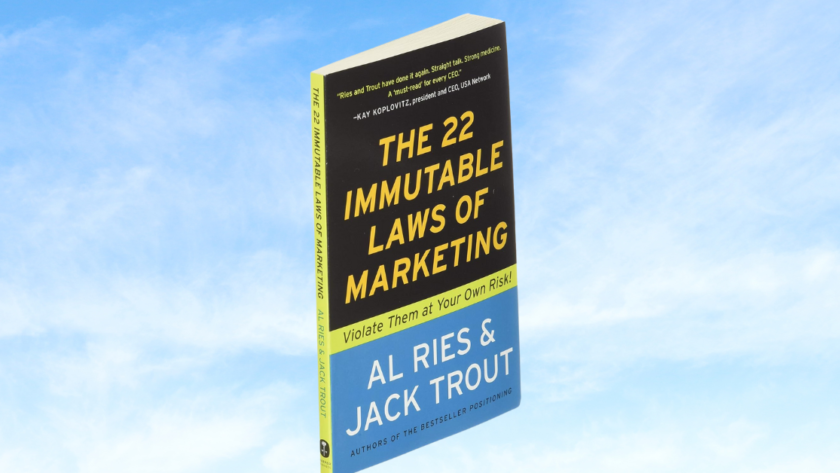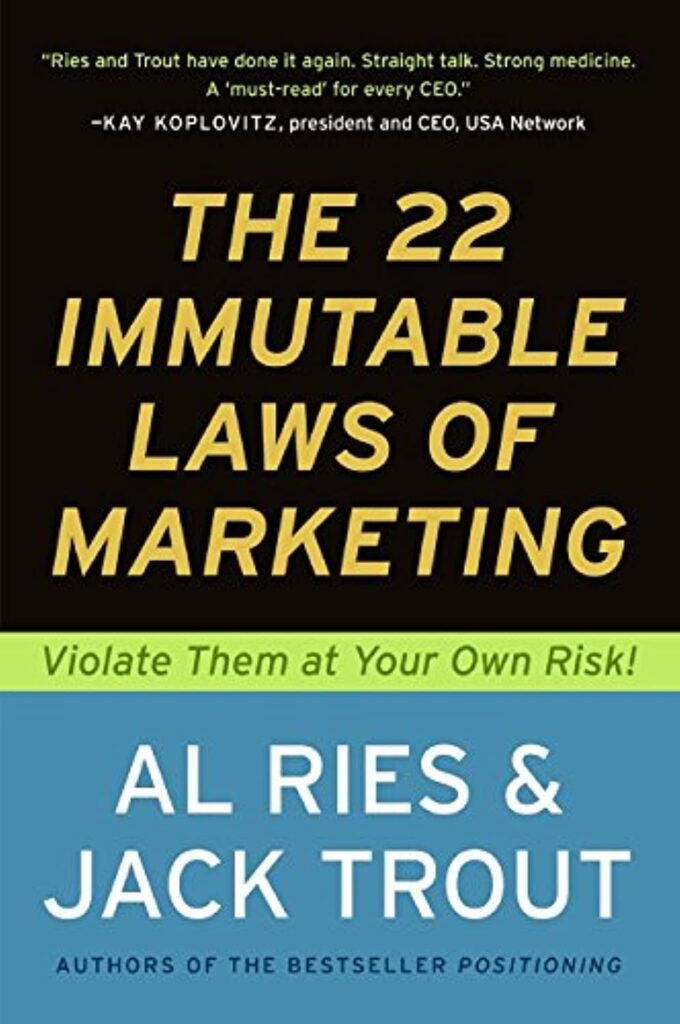Introduction
“The 22 Immutable Laws of Marketing” by Al Ries and Jack Trout has profoundly influenced marketing strategies worldwide since it’s publication in 1993.
This book presents basic principles that govern marketing success, derived from extensive analysis of real-world marketing triumphs and failures.
The core premise is straightforward yet powerful: certain unbreakable laws in marketing, when followed, significantly boost the likelihood of success.
Conversely, disregarding these laws often results in marketing disasters, regardless of a company’s size or resources.
Just a heads-up: This post contains affiliate links, so if you decide to grab a copy through my link, I might earn a small commission—at no extra cost to you. I only recommend books that offer real value, and this one’s an oldie but a goodie for any modern-day affiliate marketer!
Now, let’s dive into why The 22 Immutable Laws of Marketing deserves a spot on your reading list.
The Foundations of Marketing Success
The Law of Leadership
The first and arguably most critical law states that being first is more useful than being better. This concept underscores the importance of pioneering a category.
Companies like Amazon, Google, and Facebook didn’t necessarily offer superior products initially, but they were the first in their respective categories and have maintained their leadership positions. The key lesson here is clear: if you can’t be first in an existing category, create a new one where you can lead.
The Law of Category
This law encourages innovative thinking and market disruption. Airbnb exemplifies this principle perfectly.
Rather than competing with traditional hotels, they created an entirely new category of peer-to-peer lodging.
Similarly, Tesla didn’t simply enter the crowded automobile market – they pioneered the luxury electric vehicle category.
The Law of the Mind
Being first in the mind holds more value than being first in the marketplace. This law emphasizes the crucial role of perception in marketing.
Companies that dominate search engine results and social media conversations often have a significant advantage over their competitors.
Successful marketing involves ensuring your target audience thinks of you first when they need a solution in your category. It revolves around creating a strong mental association between your brand and the problem you solve.
The Law of Perception
Marketing revolves around perceptions, not products. This law holds even more relevance today than when it was first written.
In our era of information overload, consumer perception of a brand often carries more weight than the actual qualities of the product.
Successful brands like Apple have mastered this concept, creating a perception of innovation and luxury that extends beyond their product specifications.
They’ve built a brand image that resonates with consumers on an emotional level, often leading to fierce brand loyalty.
Practical Applications in the Digital Era
While the laws themselves stay unchanged, their application has evolved with the digital transformation of marketing. Let’s explore how some of these laws translate to modern digital marketing strategies.
The Law of Focus
Strength in one area surpasses mediocrity in many. In the digital realm, this could mean concentrating on dominating a specific niche or platform as opposed to attempting to be omnipresent.
For instance, a B2B company might focus it’s efforts on LinkedIn instead of spreading itself thin across all social media platforms.
Or a niche e-commerce store might concentrate on becoming the go-to source for a specific type of product as opposed to trying to compete with giants like Amazon on a broad range of items.
This law encourages marketers to identify their strengths and core competencies, then double down on those areas. By focusing resources and efforts, companies can establish themselves as experts in their chosen niche, leading to stronger brand recognition and customer loyalty.
The Law of Exclusivity
Two companies cannot own the same word in the prospect’s mind. This law emphasizes the importance of differentiation in digital marketing strategies.
In the digital age, this translates to owning specific keywords in search engine results and social media conversations.
Companies that dominate certain search terms often have a significant advantage in their markets.
For example, when you think of “search,” Google likely comes to mind. When you think of “professional networking,” LinkedIn probably pops up.
These companies have successfully claimed ownership of these concepts in the public consciousness.
To apply this law, marketers need to identify a unique aspect of their brand or offering that they can “own” in the minds of consumers. This could be a specific feature, a unique approach, or even a particular emotion associated with the brand.
The Law of Sacrifice
Gaining something often requires giving up something else. In the context of digital marketing, this might mean focusing on a specific social media platform or target audience instead of trying to be everywhere and appeal to everyone.
It could also mean sacrificing short-term gains for long-term brand building. For instance, a company might choose to invest heavily in content marketing, which may not yield immediate results but can build a strong foundation for future growth.
This law reminds marketers that strategic choices often involve trade-offs. By trying to please everyone or be everywhere, you risk diluting your message and impact.
Instead, by making calculated sacrifices, you can concentrate your resources where they’ll have the most significant impact.
Challenges and Criticisms
While “The 22 Immutable Laws of Marketing” offers valuable insights, it has faced it’s share of criticism. Some argue that the rapid pace of technological change and the rise of digital marketing have made some of the laws less relevant.
Critics point out that the book’s examples are outdated and don’t reflect the current business landscape. The book’s emphasis on traditional media doesn’t account for the complexities of digital and social media marketing.
However, I believe that the core principles stay sound, even if the specific examples may need updating. The key comes from understanding the underlying logic of each law and applying it creatively to current market conditions.
For instance, while the specific media channels have changed, the importance of being first in the mind (Law of the Mind) or owning a word in the prospect’s mind (Law of Exclusivity) stays as relevant as ever in our digital age.
Adapting the Laws to Different Scenarios
One of the strengths of “The 22 Immutable Laws of Marketing” is it’s versatility. These principles can be applied across various industries and business models.
Let’s explore how different types of organizations can leverage these laws:
Startups
Startups can use the Law of Category to identify untapped niches and position themselves as leaders in new markets. By creating a new category, they can avoid direct competition with established players and carve out their own space in the market.
They can also leverage the Law of the Mind to quickly establish themselves in the consciousness of their target audience through strategic digital marketing efforts.
This might involve creating viral content, leveraging influencer partnerships, or using innovative marketing techniques to grab attention in a crowded marketplace.
Established Companies
Established companies can leverage the Law of Leadership to maintain their market position by continually innovating and staying ahead of competitors.
This might involve investing in R& -D to develop new products or services, or finding new ways to add value to existing offerings.
They can also use the Law of Perception to shape how consumers view their brand in relation to newer, disruptive competitors. This might involve rebranding efforts, launching new marketing campaigns, or repositioning themselves in the market to stay relevant and appealing to consumers.
Non-Profit Organizations
Non-profit organizations can apply the Law of Focus to craft clear, compelling messages that resonate with donors and volunteers.
By focusing on a specific cause or approach, they can differentiate themselves from other organizations and create a strong, memorable brand.
They can also use the Law of Sacrifice to concentrate their limited resources on the most impactful initiatives instead of trying to solve every problem at once. This focused approach can lead to more significant results and a stronger reputation in their field.
Building on the Basics
Understanding and applying these laws is just the beginning. To truly master marketing, one must go beyond these principles and develop a deep understanding of their target audience, market dynamics, and emerging trends.
The 22 laws provide a solid foundation, but successful marketers continually build upon this base with ongoing learning and adaptation. This might involve:
- Staying up-to-date with the latest digital marketing trends and technologies.
The marketing landscape is constantly evolving, with new platforms, tools, and techniques emerging regularly.
Successful marketers make a point of staying informed about these changes and evaluating how they can be incorporated into their strategies.
- Conducting regular market research to understand shifting consumer behaviors and preferences.
Consumer needs and wants are not static – they change over time because of various factors including technological advancements, cultural shifts, and economic conditions.
Regular research helps marketers stay in tune with these changes and adjust their strategies accordingly.
- Experimenting with new marketing channels and strategies while staying true to core brand principles.
While it’s important to innovate and try new things, it’s equally crucial to maintain consistency in your brand’s core message and values.
The challenge comes from finding new ways to talk your brand’s essence across different platforms and formats.
- Developing a data-driven approach to marketing, using analytics to inform decision-making and strategy refinement.
In the digital age, we have access to an unprecedented amount of data about consumer behavior and marketing performance.
Successful marketers leverage this data to gain insights, test hypotheses, and continuously improve their strategies.
Exercises for Practical Application
To reinforce your understanding of these laws, try the following exercises:
- Identify a successful brand and analyze how it exemplifies one or more of the 22 laws.
For instance, examine how Apple embodies the Law of Perception or the Law of Category.
Consider how their marketing strategies and brand positioning align with these principles.
- Choose a struggling brand and suggest how it could improve it’s position by applying relevant laws.
For example, consider how a traditional retailer could use the Law of Division to compete with e-commerce giants.
This might involve identifying a specific niche or customer segment they could focus on to differentiate themselves.
- Brainstorm a new product or service idea and develop a marketing strategy based on these laws.
Consider how you would position it in the market.
What category would you create or dominate? How would you ensure you’re first in the mind of your target audience?
- Analyze your own company’s marketing strategy through the lens of these laws.
Are there any laws you’re currently violating?
How could you better align your strategy with these principles? This exercise can help identify potential weaknesses in your current approach and suggest areas for improvement.
- Take a recent marketing campaign that didn’t perform as well as expected. Can you identify which of the 22 laws it may have violated?
How could it have been improved?
This retrospective analysis can provide valuable insights for future campaigns.
The Law of Leadership in Action
Let’s look further into the Law of Leadership with some modern examples:
Netflix: Pioneering Streaming Entertainment
Netflix exemplifies the Law of Leadership in the streaming entertainment industry. While they didn’t invent the concept of online video (YouTube beat them to that), they were the first to successfully offer a subscription-based streaming service for movies and TV shows.
By being first in this category, Netflix gained a significant advantage. They were able to build a large user base, negotiate deals with content providers, and establish their brand as synonymous with streaming entertainment before competitors entered the market.
Even as other major players like Amazon Prime Video, Hulu, and Disney+ have entered the market, Netflix has maintained it’s leadership position.
This is largely because of the head start they gained by being first, which allowed them to build a strong brand, a large content library, and sophisticated recommendation algorithms.
Uber: Revolutionizing Transportation
Uber provides another excellent example of the Law of Leadership in action. While they weren’t the first taxi service or even the first to use technology for ride-hailing (companies like Cabulous preceded them), Uber was the first to successfully scale a peer-to-peer ridesharing model.
By pioneering this new category, Uber quickly became the go-to name for on-demand transportation. They were able to establish their brand, build a network of drivers and riders, and expand globally before significant competition emerged.
Even as competitors like Lyft have entered the market and traditional taxi services have adopted similar technologies, Uber has maintained it’s position as the market leader in most regions. This leadership position has allowed them to expand into new areas like food delivery (Uber Eats) and freight transportation.
The Challenges of Maintaining Leadership
However, being first doesn’t guarantee perpetual success. The Law of Leadership must be combined with continuous innovation and adaptation to maintain a leading position.
Companies that rest on their laurels after achieving initial success often find themselves overtaken by more innovative competitors.
For example, while MySpace was the first major social networking site to gain widespread popularity, it was eventually surpassed by Facebook.
Facebook offered a more user-friendly interface, better features, and crucially, understood and adapted to changing user needs better than MySpace did.
This underscores an important point: the Law of Leadership provides a significant advantage, but it must be leveraged effectively and combined with other strategic principles to ensure long-term success.
The Law of Category: Creating New Market Spaces
The Law of Category suggests that if you can’t be first in an existing category, you should create a new one where you can be first. This law encourages innovative thinking and can lead to the creation of entirely new markets.
Beyond Meat: Pioneering Plant-Based Meat Alternatives
Beyond Meat provides a compelling modern example of the Law of Category in action. While vegetarian and vegan food products have existed for decades, Beyond Meat created a new category: plant-based meat choices that closely mimic the taste and texture of real meat.
By focusing on creating products that appeal to meat-eaters as well as vegetarians and vegans, Beyond Meat carved out a new market space. They positioned themselves not just as a vegetarian option, but as a sustainable and healthy choice to traditional meat products.
This approach allowed Beyond Meat to differentiate themselves from both traditional meat companies and existing vegetarian brands.
By creating this new category, they were able to attract significant investment, gain widespread media attention, and secure partnerships with major restaurant chains and retailers.
Peloton: Redefining Home Fitness
Peloton offers another excellent example of creating a new category. While home exercise equipment and fitness classes have long existed as separate products, Peloton combined them to create a new category: connected fitness equipment with live and on-demand classes.
By integrating high-quality exercise bikes (and later, treadmills) with large screens and a subscription service for classes, Peloton created a unique home fitness experience.
This allowed them to differentiate themselves from both traditional gym equipment manufacturers and fitness class providers.
Peloton’s success in creating this new category has led to significant growth and inspired numerous competitors to enter the connected fitness space. However, by being first, Peloton was able to establish a strong brand presence and build a loyal customer base.
The Importance of Timing and Execution
Creating a new category is not about having a novel idea – it’s also about timing and execution. Many innovative products fail because the market isn’t ready for them or because they’re poorly executed.
For example, Microsoft introduced tablet computers in the early 2000s, but they failed to gain traction. It wasn’t until Apple introduced the iPad in 2010, with it’s user-friendly interface and ecosystem of apps, that the tablet category really took off.
This shows that successfully creating a new category requires not just innovation, and a deep understanding of consumer needs and preferences, as well as the ability to deliver a product that truly meets those needs.
The Law of the Mind: Winning the Mental Game
The Law of the Mind states that it’s better to be first in the mind than to be first in the marketplace. This law underscores the critical importance of perception and mental positioning in marketing.
Google: Owning the Concept of Search
Google provides a classic example of the Law of the Mind in action. While Google wasn’t the first search engine (predecessors included Yahoo, AltaVista, and Ask Jeeves), it has become synonymous with internet search in the minds of most consumers.
Google achieved this through a combination of superior technology (their PageRank algorithm provided better search results) and smart branding. The company name itself became a verb – people don’t “search” for information online, they “Google” it.
This mental association is so strong that even as other search engines like Bing have emerged with competitive technology, Google has maintained it’s dominant market position. Being first in the mind has proven more valuable than being first in the marketplace.
Kleenex: The Power of Genericization
Kleenex offers another powerful example of the Law of the Mind. While Kleenex wasn’t the first facial tissue on the market, it has become the generic term for all facial tissues in many parts of the world.
This level of brand recognition, where a brand name becomes the generic term for a product category, is the ultimate expression of being first in the mind. It’s so powerful that Kleenex has had to actively fight against the genericization of their trademark to protect their brand.
Strategies for Becoming First in the Mind
Becoming first in the mind requires more than just having a good product or service. It involves strategic marketing efforts aimed at creating strong mental associations.
Some strategies include:
- Consistent messaging: Repeatedly communicating your key brand attributes helps cement them in consumers’ minds.
- Emotional connection: Creating marketing that resonates emotionally with consumers can lead to stronger mental associations.
- Simplicity: Simple, clear messaging is more likely to stick in consumers’ minds than complex ideas.
- Uniqueness: Having a unique selling proposition or brand attribute makes it easier for consumers to remember and distinguish your brand.
- Omnipresence: Being visible across many channels increases the chances of your brand being top-of-mind when consumers think about your product category.
This mental positioning can provide a significant competitive advantage.
The Law of Perception: Shaping Reality
The Law of Perception posits that marketing revolves around perceptions, not products. This law holds even more relevance today than when it was first written, given our current era of information overload and constant marketing messages.
Apple: Masters of Perception
Apple stands as a prime example of a company that has mastered the Law of Perception. While Apple products are indeed high-quality, much of their success comes from how they’ve shaped consumer perceptions of their brand.
Apple has cultivated an image of innovation, sleek design, and user-friendliness. This perception is so strong that many consumers are willing to pay premium prices for Apple products, even when competitors offer similar features at lower prices.
Apple achieves this through various means:
- Carefully crafted product launches that generate excitement and anticipation.
- Minimalist, elegant product design that reinforces their brand image.
- Marketing that focuses on the user experience and lifestyle, as opposed to technical specifications.
- Retail stores designed to provide a unique, high-end shopping experience.
By consistently reinforcing these perceptions, Apple has built a brand that commands fierce loyalty and allows them to maintain high profit margins.
The Importance of Brand Storytelling
In the digital age, brand storytelling has become a crucial tool for shaping perceptions. Consumers are increasingly interested not just in what a company sells, but in what it stands for.
Companies like TOMS Shoes have leveraged this effectively. TOMS built it’s brand around the story of it’s one-for-one giving model, where for every pair of shoes purchased, they donate a pair to a child in need. This story shaped consumer perceptions of TOMS as a socially responsible brand, driving sales and customer loyalty.
Managing Negative Perceptions
The Law of Perception also applies to managing negative perceptions. When faced with a PR crisis or negative publicity, how a company responds can significantly impact public perception.
For example, when Tylenol faced a crisis in 1982 because of product tampering, they responded quickly and transparently, recalling all products and introducing new tamper-proof packaging. This response helped maintain public trust and allowed the brand to recover.
Conversely, when BP faced the Deepwater Horizon oil spill in 2010, their initial response was perceived as slow and inadequate, severely damaging public perception of the company.
Strategies for Shaping Perception
To effectively shape perception, consider the following strategies:
- Consistency: Ensure all touchpoints with your brand reinforce the desired perception.
- Authenticity: In the age of social media, consumers can quickly spot inauthentic messaging.
Ensure your brand’s actions align with it’s stated values.
- Emotional appeal: Perceptions are often shaped more by emotion than logic.
Create marketing that resonates emotionally with your target audience.
- Social proof: Leverage customer testimonials, influencer partnerships, and social media to reinforce positive perceptions of your brand.
- Transparency: In times of crisis or negative publicity, open and honest communication can help maintain trust and positive perceptions.
Remember, perception is reality in marketing. By understanding and applying the Law of Perception, you can shape how consumers view your brand, potentially giving you a significant advantage over competitors.
Review your own copy of “The 22 Immutable Laws of Marketing” by clicking here.
Frequently Asked Questions
What are the 22 immutable laws of marketing?
The 22 immutable laws of marketing are a set of basic principles for effective marketing strategies, outlined in the book by Al Ries and Jack Trout. They include laws such as the Law of Leadership, the Law of Category, the Law of the Mind, and the Law of Perception, among others.
Who wrote The 22 Immutable Laws of Marketing?
“The 22 Immutable Laws of Marketing” was written by Al Ries and Jack Trout, two renowned marketing strategists. The book was first published in 1993 and has since become a classic in marketing literature.
Is The 22 Immutable Laws of Marketing still relevant?
The basic concepts about human psychology and market dynamics continue to apply, even as marketing channels and technologies evolve.
How can I apply the Law of Leadership in digital marketing?
Applying the Law of Leadership in digital marketing involves being the first to establish a strong presence in a new digital space or category. This could mean being the first to effectively use a new social media platform, pioneering a new type of digital content, or creating a new category of digital product or service.
What is the Law of Category and how does it work?
The Law of Category suggests that if you can’t be first in an existing category, you should create a new one where you can be first. This involves identifying an unmet need or a new way of framing an existing product or service, and positioning yourself as the leader in this new category.
How does the Law of the Mind differ from the Law of the Market?
The Law of the Mind states that it’s better to be first in the mind than to be first in the marketplace. This means that consumer perception is more important than actual market entry.
The Law of the Market, on the other hand, focuses on being first to market with a product or service.
Can you give an example of a company successfully applying the Law of Perception?
Apple is a great example of a company successfully applying the Law of Perception. They’ve shaped consumer perceptions of their brand as innovative, user-friendly, and high-quality, allowing them to command premium prices and maintain strong brand loyalty.
How can small businesses use the 22 immutable laws of marketing?
Small businesses can use the 22 immutable laws of marketing by focusing on niche markets (Law of Category), building strong brand perceptions (Law of Perception), and aiming to be the leader in their specific market segment (Law of Leadership). These laws can help small businesses compete effectively against larger competitors.
What is the Law of Sacrifice in marketing?
The Law of Sacrifice states that you have to give up something to get something. In marketing, this often means focusing on a specific target market, product line, or marketing message, as opposed to trying to be everything to everyone.
How do the 22 immutable laws of marketing apply to digital marketing?
The 22 immutable laws of marketing apply to digital marketing in various ways. For example, the Law of Category can be applied by creating new types of digital content or services.
The Law of the Mind is crucial in SEO and social media marketing, where being top-of-mind is key.
The Law of Perception is vital in managing online reputation and brand image.
Key Takeaways
- The 22 laws provide timeless principles that can guide marketing strategy in any era.
- Being first in a category or in the mind of the consumer is often more important than being the best.
- Perception is reality in marketing – how consumers view your brand is crucial.
- Focus and sacrifice are necessary for effective marketing – you can’t be everything to everyone.
- These laws should be adapted and applied creatively in the digital age.





